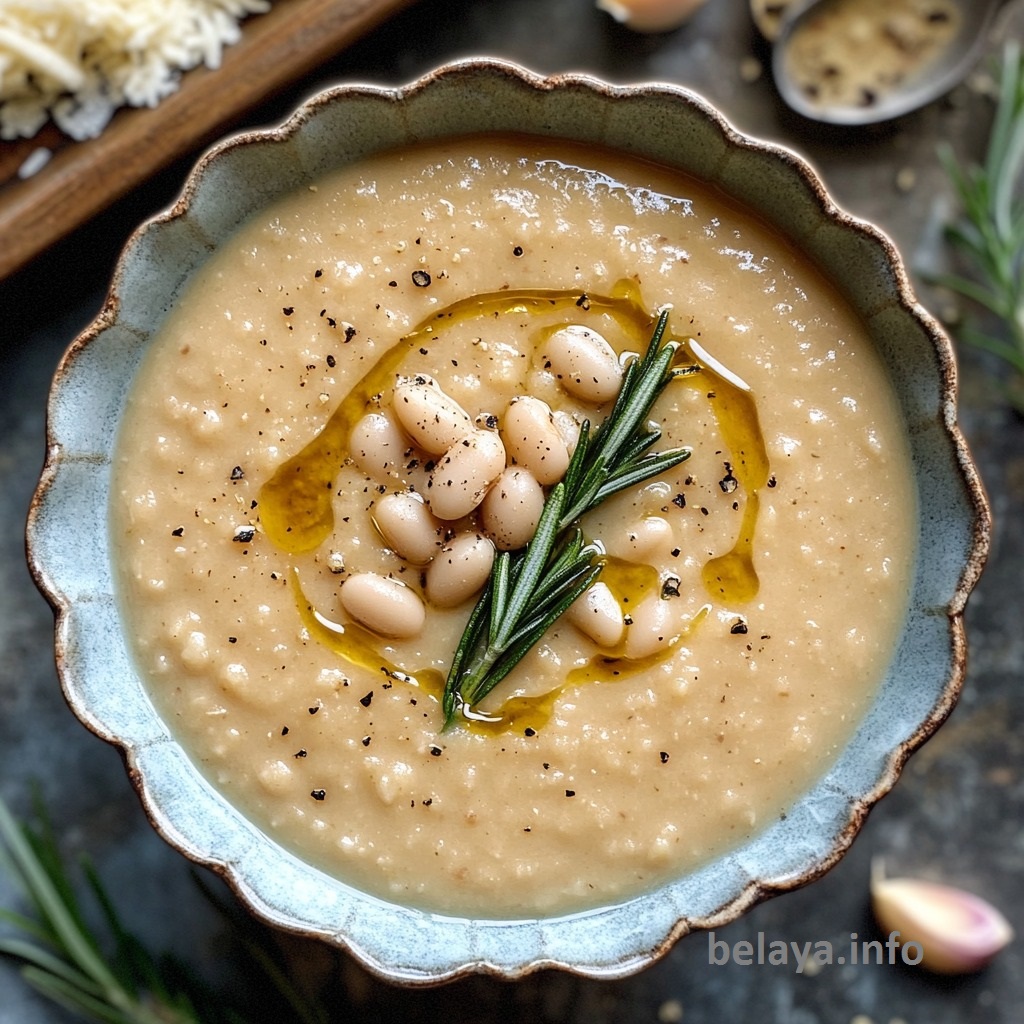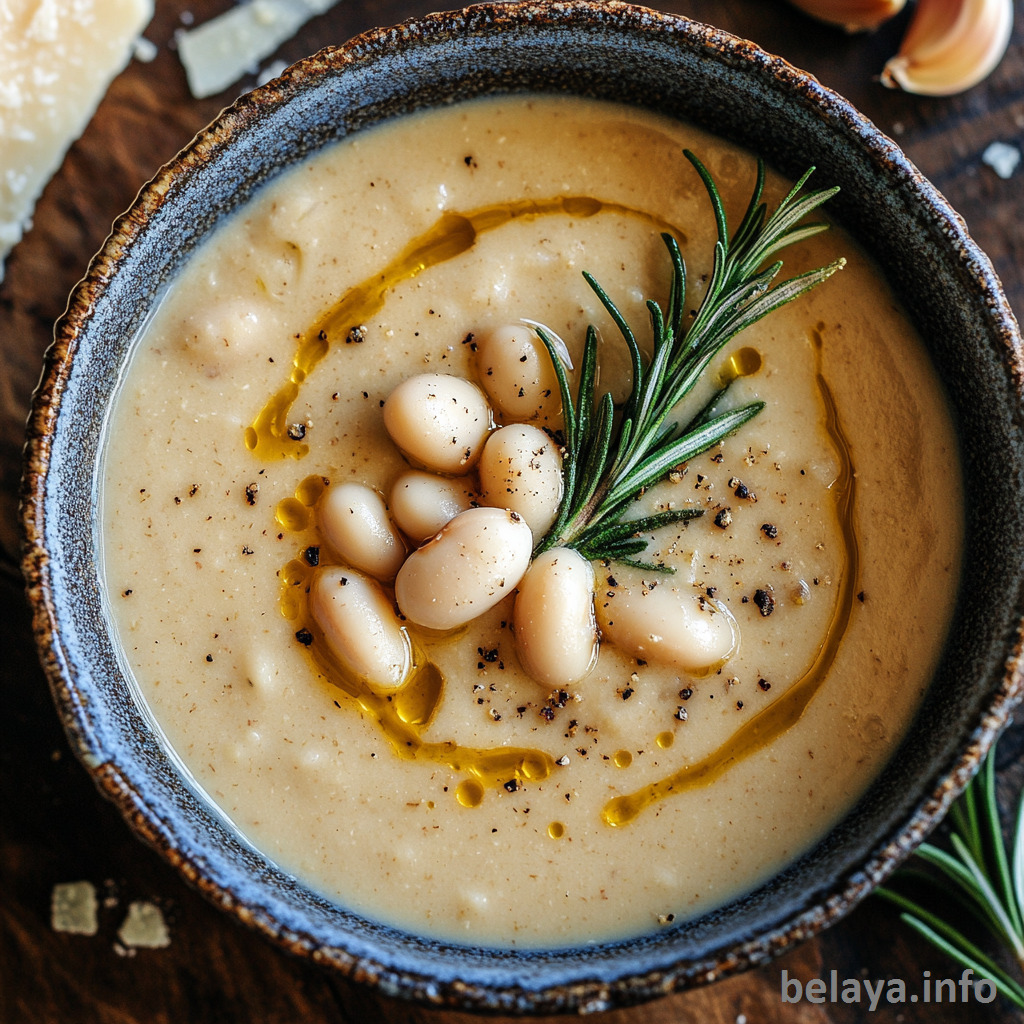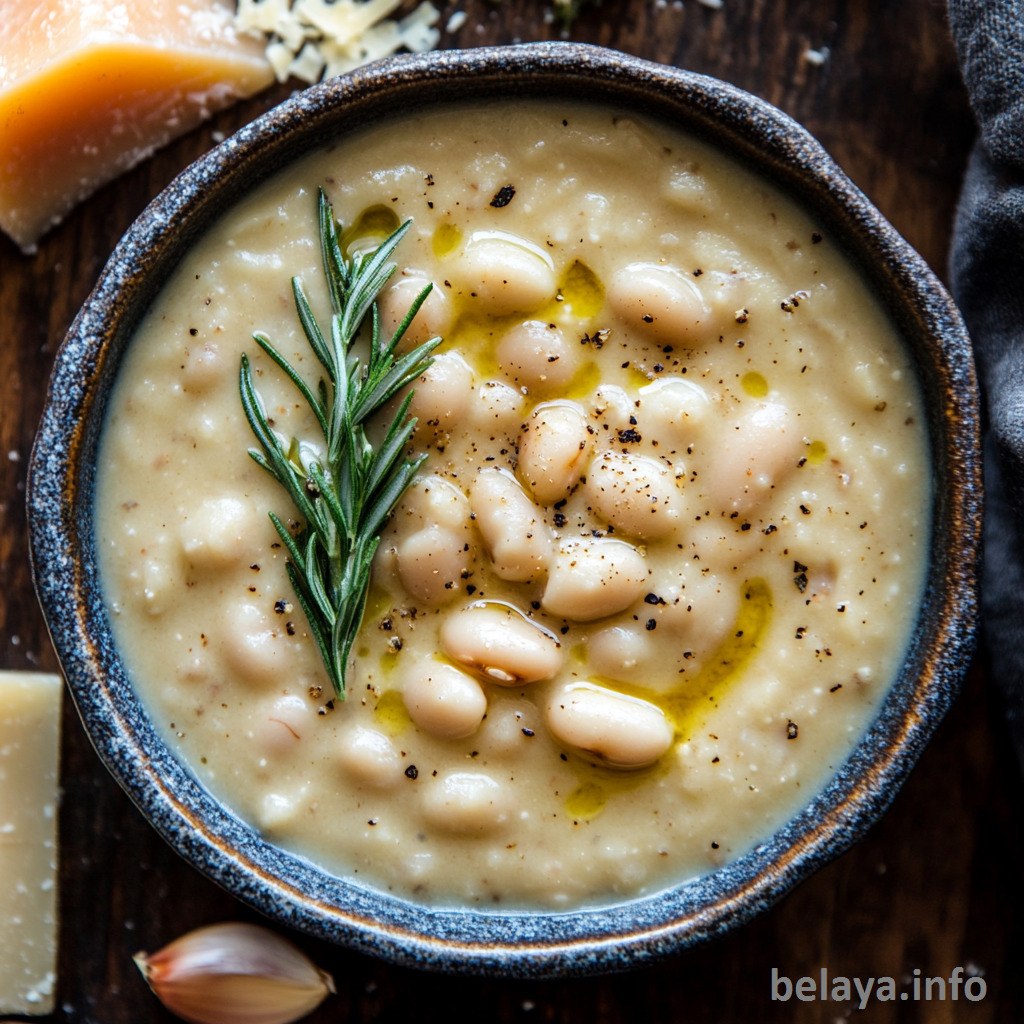Rosemary and Roasted Garlic White Bean Soup
This soup is comfort in its purest form—a warm, velvety bowl infused with the earthy aroma of rosemary and the deep, mellow sweetness of slow-roasted garlic. Each spoonful is rich yet nourishing, hearty without being heavy.
The white beans provide a creamy, protein-packed base, while a splash of lemon and sprinkle of parmesan add brightness and depth.
Whether served as a rustic starter or a stand-alone meal with crusty bread, this soup is the kind of dish that invites you to slow down, breathe in the aroma, and savor the simple beauty of wholesome ingredients done right.

Why people will love the Rosemary and Roasted Garlic White Bean Soup:
Deeply comforting and soul-warming – The roasted garlic infuses the soup with a mellow, caramelized sweetness that soothes and satisfies, especially on cold or cozy evenings.
Rich in flavor, light on effort – While the soup tastes like it simmered all day, it comes together easily with pantry staples and simple techniques, making it both accessible and impressive.
Wholesome and nourishing – Packed with fiber-rich white beans, protein, and immune-boosting garlic, this soup supports wellness without sacrificing taste.
Elegant and rustic at once – With fragrant rosemary, creamy beans, and the nutty bite of parmesan, the soup balances refined flavor with rustic charm.
Flexible for every eater – Naturally gluten-free and easily made vegetarian or vegan, it’s a crowd-pleasing recipe that adapts to dietary needs without compromising depth.
Perfect for make-ahead meals – Like many great soups, the flavors deepen over time, making it ideal for batch cooking or preparing in advance for the week ahead.

Key Ingredients:
Roasted Garlic:
The heart of this soup—slow-roasted until golden and buttery-soft, garlic transforms from sharp and pungent to sweet, mellow, and deeply aromatic. It adds a velvety richness that no shortcut can replicate.
White Beans (Cannellini or Great Northern):
These creamy legumes create a naturally thick, silky base, offering both substance and subtle earthiness. They absorb the garlic and rosemary beautifully, acting as both flavor carrier and comforting filler.
Fresh Rosemary:
Woodsy and aromatic, rosemary delivers an herbal depth that elevates the soup from simple to soulful. It pairs seamlessly with beans and garlic, lending a touch of Mediterranean warmth.
Onion and Fresh Garlic:
This classic aromatic duo forms the savory foundation of the soup. The onion brings sweetness and balance, while the fresh garlic deepens the flavor without overpowering the roasted cloves.
Chicken or Vegetable Broth:
A high-quality broth enhances every component—acting as a liquid canvas that pulls the roasted garlic, beans, and herbs into harmony.
Lemon Juice:
Just a splash of fresh lemon cuts through the richness, awakening the palate and bringing brightness to the dish’s earthy undertones.
Parmigiano Reggiano (Optional):
Adds a savory, umami-rich finish that enhances both creaminess and depth. It’s a luxurious layer that rounds out the soup, though it’s optional for those seeking a dairy-free option.

Expert Tips:
Roast the garlic low and slow for depth of flavor:
Roasting garlic at 350°F for up to 90 minutes allows the natural sugars to caramelize fully, turning harshness into a soft, nutty sweetness. Don’t rush this step—it’s the soul of the soup.
Use multiple textures of garlic for complexity:
The soup combines three forms of garlic: roasted (sweet and mellow), fresh minced (sharp and fragrant), and sautéed (savory and warm). Together, they create layers of flavor that evolve with every bite.
Blend a portion for creaminess (optional):
For a creamier consistency without cream, blend half the soup and stir it back in. This gives it a silky body while still leaving some texture and whole beans intact.
Sauté aromatics slowly to build flavor:
Don’t rush the onion and garlic base—cook it low and slow until translucent and fragrant. This gentle method draws out their natural sweetness and prevents bitterness.
Finish with acid and seasoning at the end:
Lemon juice and salt should be added last so you can taste and balance. Acid brightens the soup and sharpens flavors that might otherwise seem muted after simmering.
Let the soup rest before serving:
Like many bean soups, this one improves after sitting for a short while off the heat. It allows the beans to absorb more flavor and the roasted garlic to fully meld into the broth.
Use homemade broth if possible:
A good broth is the backbone of flavor. If you have time, use homemade chicken or vegetable stock—it will provide more richness and nuance than store-bought varieties.

Rosemary and Roasted Garlic White Bean Soup
Roasting the Garlic:
3 heads garlic, top 1/8 inch trimmed
1 tablespoon oil
Method:
Preheat your oven to 350°F (180°C).
Slice off the top 1/8 inch of each garlic bulb to expose the cloves.
Drizzle a bit of oil over the cut tops, wrap the bulbs in foil, and roast for 60 to 90 minutes, until golden, soft, and deeply aromatic.
Let cool slightly, then squeeze the garlic cloves from their skins when ready to add to the soup.
For the Soup:
1 tablespoon oil
1 onion, finely chopped
3 cloves garlic, minced
4 cups chicken broth (or vegetable broth)
3 (14.5-ounce) cans white beans, rinsed and drained
2 teaspoons fresh rosemary, finely chopped (or 1 teaspoon dried rosemary)
1/4 cup grated parmigiano reggiano (parmesan cheese) (optional)
1 tablespoon lemon juice
Salt and pepper, to taste
Method:
In a large soup pot, heat oil over medium heat.
Add the chopped onion and sauté until translucent and fragrant, about 5 to 7 minutes.
Stir in the minced garlic and cook for 1 more minute, being careful not to let it burn.
Pour in the broth, then add the white beans and chopped rosemary. Bring to a gentle boil.
Reduce the heat and let simmer for about 5 minutes to allow the flavors to meld.
Squeeze the roasted garlic cloves directly into the pot and stir thoroughly to infuse the soup with rich, sweet garlic flavor.
Stir in the parmesan cheese (if using) and lemon juice.
Season with salt and black pepper to taste.
Serve warm, with extra cheese or herbs if desired.

Important Notes When Making Rosemary and Roasted Garlic White Bean Soup:
Roasting garlic is non-negotiable for depth and sweetness:
Roasted garlic is what sets this soup apart from ordinary bean soups. It adds a subtle, caramelized richness that raw or sautéed garlic alone can’t replicate. Be patient—it’s worth every minute in the oven.
Use quality beans and rinse them well:
Canned beans are convenient, but rinsing them thoroughly removes excess starch and sodium, resulting in a cleaner-tasting soup. If using dried beans, soak and cook them fully beforehand for a silkier texture and better flavor absorption.
Balance rosemary carefully—it’s potent:
Fresh rosemary adds earthiness and a piney aroma, but too much can overwhelm. Chop it finely to release its oils, and measure with a light hand—especially if using dried.
Don’t skip the lemon juice:
Though subtle, that final splash of lemon is essential. It cuts through the creaminess of the beans and garlic, lifting the entire flavor profile and keeping the soup from feeling too heavy.
Parmigiano Reggiano is a flavor booster, not just a topping:
Stirred into the soup, parmesan adds a layer of umami that deepens flavor without needing excess salt. For vegan versions, a touch of nutritional yeast or a dash of white miso can replicate that savory note.
Taste and adjust after the garlic goes in:
Roasted garlic is sweet and mellow, but once it’s incorporated, it can subtly alter the seasoning balance. Always re-taste for salt, acid, and body before serving.
Soup thickens as it sits:
This bean-based soup naturally thickens over time, especially when cooled and reheated. If serving later, be prepared to add a splash of broth or water to return it to your desired consistency.

How to Enjoy Rosemary and Roasted Garlic White Bean Soup After Cooking
Let the Soup Rest Briefly
After simmering, allow the soup to rest off the heat for 5–10 minutes. This short pause lets the flavors settle and deepen. The beans continue to absorb the garlic and rosemary essence, making each spoonful richer and more cohesive.
Serve It Warm (Not Boiling Hot)
Serve the soup warm rather than piping hot. This allows the subtle flavors—roasted garlic’s sweetness, the herbaceous rosemary, the umami from parmesan—to shine through without being masked by heat.
Pair with the Right Side
Crusty Bread: A thick slice of toasted sourdough or a rustic baguette is ideal for dipping and scooping the creamy broth.
Simple Salad: A lemony arugula or mixed greens salad adds a crisp, fresh counterpoint to the soup’s creaminess.
Optional Protein Add-On: For a heartier meal, top with a poached egg or serve alongside roasted chicken thighs.
Garnish Intentionally
Fresh herbs: Sprinkle with chopped parsley or a few rosemary leaves for brightness and contrast.
Extra parmesan: Add a final dusting of finely grated Parmigiano Reggiano for a savory finish.
Lemon wedge: A small squeeze of fresh lemon juice at the table elevates and balances every flavor in the bowl.
Sip Something Complementary
Wine pairing: A glass of dry white wine (like Chardonnay or Vermentino) brings out the soup’s savory, herbal notes.
Non-alcoholic: Try a sparkling water with a slice of lemon or a lightly brewed herbal tea, such as chamomile or thyme.
Make it a Moment
Serve this soup as more than just a meal—it’s a quiet comfort, perfect for slow evenings or restorative lunches. Light a candle, use your favorite bowl, and savor each spoonful slowly. The warmth, aroma, and creamy texture invite a moment of pause and peace.

Nutrition Information:
Per serving for Rosemary and Roasted Garlic White Bean Soup, assuming the recipe yields 6 servings and includes optional parmesan cheese:
Calories: 240 kcal | Total Fat: 7.6 g | Saturated Fat: 1.4 g | Monounsaturated Fat: 4.2 g | Polyunsaturated Fat: 0.9 g | Cholesterol: 5 mg | Sodium: 620–780 mg (depending on broth and added salt) | Total Carbohydrates: 32 g | Dietary Fiber: 8.7 g | Sugars: 1.6 g | Protein: 12 g

Frequently Asked Questions:
Can I use dried beans instead of canned?
Yes, absolutely. If using dried white beans (like cannellini or great northern), soak them overnight and cook them until tender before adding to the soup. This adds depth of flavor and gives you more control over texture and sodium levels.
How can I make this soup vegan?
Simply use vegetable broth instead of chicken broth and omit the parmesan cheese. For extra depth, consider adding a spoonful of white miso or nutritional yeast as a savory, umami-rich substitute.
Do I need to peel the roasted garlic before adding it to the soup?
No peeling necessary—just squeeze the soft, caramelized cloves directly out of the skin and into the pot. They’ll melt into the broth and infuse it with deep, sweet flavor.
Can I freeze this soup?
Yes, this soup freezes well. Let it cool completely, then store in an airtight container for up to 3 months. Reheat gently on the stove, and add a splash of broth or water if it thickens too much.
What should I serve with this soup for a complete meal?
Crusty bread (like a rustic sourdough), a simple green salad, or a side of roasted vegetables pair beautifully. You can also serve it as a starter before a main course of roasted chicken or grilled vegetables.
How do I know when the garlic is roasted enough?
The garlic is ready when the cloves are deeply golden, very soft to the touch, and easily squeezed from their skins. The aroma will be sweet and nutty, not sharp or pungent. Undercooked garlic won’t deliver the same rich flavor.
Should I blend the soup for a smoother texture?
That depends on your preference. For a silky, creamy finish, you can blend all or part of the soup using an immersion blender. Leaving some whole beans intact adds texture and heartiness.
When should I add the roasted garlic during cooking?
Add it after the soup has simmered and the beans have had time to absorb the rosemary and broth flavors. This allows the sweet, roasted garlic to retain its depth and melt fully into the base without getting lost.
What’s the best way to avoid over-seasoning the soup?
Wait until after you’ve added the roasted garlic and any cheese before seasoning with salt. The broth, parmesan, and beans already contribute to the salt content, so taste at the end and adjust carefully.
How can I deepen the flavor if I don’t have time to roast garlic?
While roasted garlic is ideal, in a pinch, you can sauté minced garlic slowly in olive oil until golden—then add a splash of balsamic vinegar or a pinch of smoked paprika to mimic some of the roasted sweetness and depth.